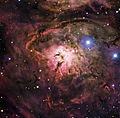Súbor:Lagoon Nebula.jpg

Veľkosť tohto náhľadu: 610 × 599 pixelov. Iné rozlíšenia: 244 × 240 pixelov | 489 × 480 pixelov | 782 × 768 pixelov | 1 043 × 1 024 pixelov | 1 841 × 1 808 pixelov .
Pôvodný súbor (1 841 × 1 808 pixelov, veľkosť súboru: 2,92 MB, MIME typ: image/jpeg)
História súboru
Po kliknutí na dátum/čas uvidíte ako súbor vyzeral vtedy.
| Dátum/Čas | Náhľad | Rozmery | Používateľ | Komentár | |
|---|---|---|---|---|---|
| aktuálna | 00:20, 4. marec 2014 |  | 1 841 × 1 808 (2,92 MB) | Lmbuga | Putting the nebula in the center of the image |
| 07:48, 9. august 2012 |  | 2 027 × 2 064 (1,59 MB) | Fabian RRRR | higher resolution | |
| 07:32, 22. apríl 2010 |  | 1 280 × 1 303 (317 KB) | EricHS211 | {{Information |Description={{en|1=Infrared view of the Cat’s Paw Nebula (NGC 6334) taken by VISTA. NGC 6334 is a vast region of star formation about 5500 light-years from Earth in the constellation of Scorpius. The whole gas cloud is about 50 light-year |
Použitie súboru
Na tento súbor odkazujú nasledujúce 2 stránky:
Globálne využitie súborov
Nasledovné ďalšie wiki používajú tento súbor:
- Použitie na ady.wikipedia.org
- Použitie na alt.wikipedia.org
- Použitie na av.wikipedia.org
- Použitie na bn.wikipedia.org
- Použitie na cs.wikipedia.org
- Použitie na cv.wikipedia.org
- Použitie na de.wikipedia.org
- Použitie na en.wikipedia.org
- Použitie na et.wikipedia.org
- Použitie na fr.wikipedia.org
- Použitie na hu.wikipedia.org
- Použitie na kaa.wikipedia.org
- Použitie na kk.wikipedia.org
- Použitie na koi.wikipedia.org
- Použitie na ko.wikipedia.org
- Použitie na kv.wikipedia.org
- Použitie na lez.wikipedia.org
- Použitie na mdf.wikipedia.org
- Použitie na mg.wikipedia.org
- Použitie na mk.wikipedia.org
- Použitie na mrj.wikipedia.org
- Použitie na olo.wikipedia.org
- Použitie na os.wikipedia.org
- Použitie na pl.wikipedia.org
- Použitie na pt.wikipedia.org
Zobraziť ďalšie globálne použitie tohto súboru.


